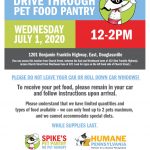We attend a lot of parties, potlucks, and dinners throughout the holiday season. Noisy kids, old friends, and swarms of distant relatives can distract us when we’re preparing, serving, and cleaning up food. It can be easy to make a mistake that puts the health of your friends and family at risk.
When preparing a large meal, we often store more food in the refrigerator than usual. To reduce the risk of cross-contamination by transferring disease-causing bacteria from raw meat, poultry, and eggs to cooked food or fruits and vegetables, store raw meat, poultry, and eggs on the bottom shelf; and for added protection, store them in plastic grocery bags or on trays to contain any juices that may drip. Do not overload the refrigerator. Consider storing beverages in a cooler with ice to save refrigerator space. Finally, use a thermometer to ensure the temperature stays below 40°F.
It can be easy to forget to thoroughly clean up after handling raw meat, poultry, and eggs. Wash your hands with soap and warm water for at least 20 seconds. You also need to pay attention and immediately clean surfaces like countertops, cutting boards, and mixing bowls with hot, soapy water. You don’t want an arriving guest to place the dessert they brought onto a dirty surface!
It may take a little planning to thaw food safely. The easiest method is to thaw food in the refrigerator. For a turkey, plan 24 hours for each 5 lbs of meat; this could be up to 5 days for a large bird. In general, if you need to thaw food faster, you can place food in cold running water, cook it directly from frozen, or thaw in the microwave.
It is important to make sure that all food is cooked to the proper temperature to destroy disease-causing bacteria. Seafood, steaks, roasts, and pork need to be cooked to 145°F. Ground beef and egg dishes need to be cooked to 160°F and poultry needs to be cooked to 165°F. Measure the temperature of these foods with a calibrated food thermometer in the thickest part of the food and in multiple locations to make sure it is cooked completely.
After the meal, it can be easy to forget about leftover food that’s in the kitchen or sitting on the table. For dense foods like casseroles, separate leftovers into smaller containers which allows the food to cool faster. Aim to store leftovers in the fridge or freezer within two hours, but let them cool before placing them in the fridge. Placing large quantities of hot food in the fridge can raise the temperature of the other food and put it at risk. Eat or freeze leftovers within 3-4 days. If you’re sending leftovers home with your guests, buy some extra ice packs to keep the food cold on the trip home.




